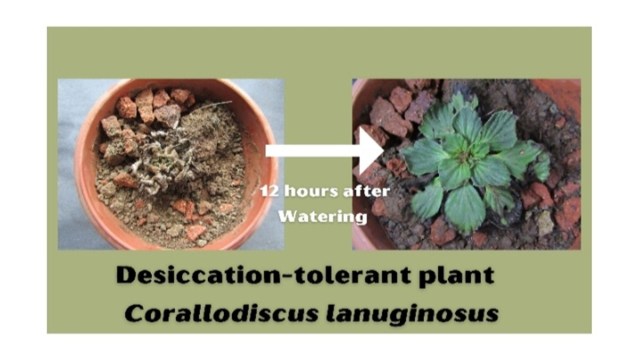Pune researchers discover plant species from Western Ghats that survive without water for 8 months
These species can withstand extreme dehydration, that is, when the water loss can be as high as 95%.
 A DT plant showing signs of rejuvenation after hours of watering (Source: ARI)
A DT plant showing signs of rejuvenation after hours of watering (Source: ARI) A team of researchers from the Pune-based Agharkar Research Institute has discovered on the Western Ghats more than 30 new plant species capable of surviving extreme dehydration and arid conditions.
A new field study, led by Mandar Datar, noted that these plants—scientifically known as desiccation-tolerant (DT) vascular plant species—can stay alive without water for nearly eight months. So much so that these species can withstand extreme dehydration, that is, when the water loss can be as high as 95 per cent.
“These plants lower their metabolism rate and break down the chlorophyll during the periods when there is no water availability post the year’s southwest monsoon season lasting for four months. While not all leaves survive, some that do were found to rejuvenate following a fresh spell of rain,” Datar told The Indian Express.
Among the newly discovered DT plant species, 12 were found growing only along the Western Ghats, whereas 16 were endemic to India. With this latest identification, the total known DT species from India has now risen to 62. Globally, about 350 have been identified, the botanists said.
The Western Ghats, one of the 36 biodiversity hotspots in the world, comprises 1,600km-long ranges running through Gujarat, Maharashtra, Goa, Karnataka, Tamil Nadu and Kerala, and covers a total area of 1.60 lakh sq km. It is an important hotspot for DT plant species. In addition to rock outcrops, some tree trunks growing along the shaded forests, too, are crucial habitats to support the growth of the DT species here, the Indian researchers, who collaborated with Stefan Porembksi from the Rostock University, Germany, noted in the study published in the Nordic Journal of Botany.
During the study, the researchers scrutinised the outcrop species to check for their DT properties by undertaking seasonal field observations along the northern Western ghats in Maharashtra, Goa and Karnataka. This was followed by water-content estimation protocols.
(Anjali Marar works at the Raman Research Institute, Bengaluru.)




































